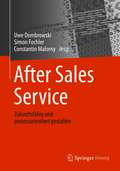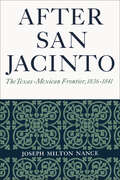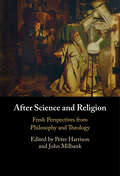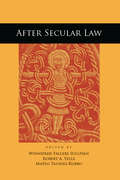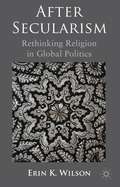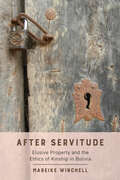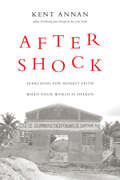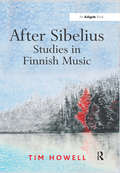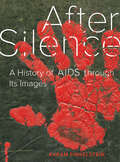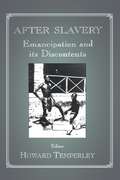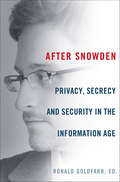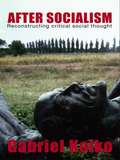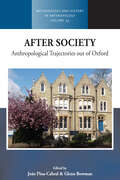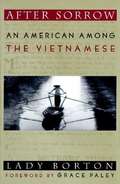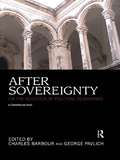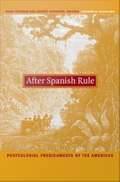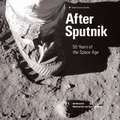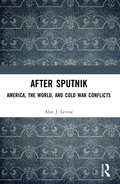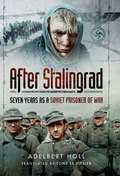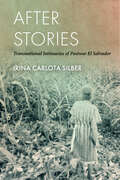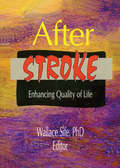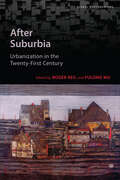- Table View
- List View
After Sales Service: Zukunftsfähig und prozessorientiert gestalten
by Uwe Dombrowski Simon Fochler Constantin MalornyDer After Sales Service ist ein Unternehmensbereich, der zunehmend bedeutender für produzierende Unternehmen wird. Ziel des Buches ist es, Theorie und Praxis zusammenzuführen. Daher sollen Methodiken sowie praxis- und lösungsorientierte Handlungsempfehlungen gegeben werden, die es dem Leser ermöglichen, einen effektiven After Sales Service aufzubauen oder Unterstützung bei der After Sales Service-Einführung zu bekommen. Aus diesem Grund werden die drei Teilbereiche des After Sales Service auf theoretischer Basis detailliert beschrieben. Hierbei wird der Fokus auch auf die Serviceplanung als Querschnittsprozess zwischen strategischer Planung und operativer Ausführung des After Sales Service gelegt. Ferner wird der Paradigmenwechsel von der Funktionsorientierung hin zu einer Prozessorientierung beschrieben. Aber auch Trends, wie Service Transition oder Servitization, Geschäftsmodelle im Service, Lean After Sales Service, Globalisierung und die damit einhergehenden Folgen für das Service-Netzwerk oder die Entwicklungen im Rahmen der Industrie 4.0, wie zum Beispiel Smart Services, Anwendungen der Augmented Reality oder Predictive Maintenance. Außerdem werden neue Arten der Führung beschrieben, wie beispielsweise das Lean Leadership, die im After Sales Service genutzt werden können.
After San Jacinto: The Texas-Mexican Frontier, 1836–1841
by Joseph Milton NanceA balanced account of the skirmishes along Texas&’ borderland during the years between the Battle of San Jacinto and the Mexican seizure of San Antonio. The stage was set for conflict: The First Congress of the Republic of Texas had arbitrarily designated the Rio Grande as the boundary of the new nation. Yet the historic boundaries of Texas, under Spain and Mexico, had never extended beyond the Nueces River. Mexico, unwilling to acknowledge Texas independence, was even more unwilling to allow this further encroachment upon her territory. But neither country was in a strong position to substantiate claims; so the conflict developed as a war of futile threats, border raids, and counterraids. Nevertheless, men died—often heroically—and this is the first full story of their bitter struggle. Based on original sources, it is an unbiased account of Texas-Mexican relations in a crucial period. &“Solid regional history.&” —The Journal of Southern History
After San Jacinto: The Texas-Mexican Frontier, 1836–1841
by Joseph Milton NanceA balanced account of the skirmishes along Texas&’ borderland during the years between the Battle of San Jacinto and the Mexican seizure of San Antonio. The stage was set for conflict: The First Congress of the Republic of Texas had arbitrarily designated the Rio Grande as the boundary of the new nation. Yet the historic boundaries of Texas, under Spain and Mexico, had never extended beyond the Nueces River. Mexico, unwilling to acknowledge Texas independence, was even more unwilling to allow this further encroachment upon her territory. But neither country was in a strong position to substantiate claims; so the conflict developed as a war of futile threats, border raids, and counterraids. Nevertheless, men died—often heroically—and this is the first full story of their bitter struggle. Based on original sources, it is an unbiased account of Texas-Mexican relations in a crucial period. &“Solid regional history.&” —The Journal of Southern History
After Science and Religion: Fresh Perspectives from Philosophy and Theology
by John Milbank Peter Harrison Paul TysonThe popular field of 'science and religion' is a lively and well-established area. It is however a domain which has long been characterised by certain traits. In the first place, it tends towards an adversarial dialectic in which the separate disciplines, now conjoined, are forever locked in a kind of mortal combat. Secondly, 'science and religion' has a tendency towards disentanglement, where 'science' does one sort of thing and 'religion' another. And thirdly, the duo are frequently pushed towards some sort of attempted synthesis, wherein their aims either coincide or else are brought more closely together. In attempting something fresh, and different, this volume tries to move beyond tried and tested tropes. Bringing philosophy and theology to the fore in a way rarely attempted before, the book shows how fruitful new conversations between science and religion can at last move beyond the increasingly tired options of either conflict or dialogue.
After Secular Law
by Winnifred Fallers Sullivan Robert A. Yelle Mateo Taussig-RubboMany today place great hope in law as a vehicle for the transformation of society and accept that law is autonomous, universal, and above all, secular. Yet recent scholarship has called into question the simplistic narrative of a separation between law and religion and blurred the boundaries between these two categories, enabling new accounts of their relation that do not necessarily either collapse them together or return law to a religious foundation. This work gives special attention to the secularism of law, exploring how law became secular, the phenomenology of the legal secular, and the challenges that lingering religious formations and other aspects of globalization pose for modern law's self-understanding. Bringing together scholars with a variety of perspectives and orientations, it provides a deeper understanding of the interconnections between law and religion and the unexpected histories and anthropologies of legal secularism in a globalizing modernity.
After Secularism
by Erin K. WilsonHaving destabilized dominant assumptions about the nature of religion, there is now a need to develop new ways of thinking about this ever-present phenomenon in global politics. This book outlines a new approach to understanding religion and its relationship with politics in the West and globally for International Relations.
After Servitude: Elusive Property and the Ethics of Kinship in Bolivia
by Dr. Mareike WinchellHow are injurious pasts redeployed by the dispossessed? After Servitude explores how agrarian engineers, Indigenous farmers, Mestizo mining bosses, and rural workers navigate racial hierarchies rooted in histories of forced agrarian labor. In the rural Bolivian province of Ayopaya, where the liberatory promises of property remain elusive, Quechua people address such hierarchies by demanding aid from Mestizo elites and, when that fails, through acts of labor militancy. Against institutional faith in property ownership as a means to detach land from people and present from past, the kin of former masters and servants alike have insisted that ethical debts from earlier racial violence stretch across epochs and formal land sales. What emerges is a vision of justice grounded in popular demands that wealth remain beholden to the region’s agrarian past. By tracing Ayopayans’ active efforts to contend with servitude’s long shadow, Mareike Winchell illuminates the challenges that property confronts as both an extractive paradigm and a means of historical redress.
After Sex?: On Writing Since Queer Theory
by Janet Halley Andrew ParkerSince queer theory originated in the early 1990s, its insights and modes of analysis have been taken up by scholars across the humanities and social sciences. In After Sex? prominent contributors to the development of queer studies offer personal reflections on the field's history, accomplishments, potential, and limitations. They consider the purpose of queer theory and the extent to which it is or is not defined by its engagement with sex and sexuality. For many of the contributors, a broad notion of sexuality is essential to queer thought. At the same time, some of them caution against creating an all-embracing idea of queerness, because it empties the term "queer" of meaning and assumes the universality of ideas developed in the North American academy. Some essays recall the political urgency of the late 1980s and early 1990s, when gay and lesbian activist and queer theory projects converged in response to the AIDS crisis. Other pieces exemplify more recent trends in queer critique, including the turn to affect and the debates surrounding the "antisocial thesis," which associates queerness with the repudiation of heteronormative forms of belonging. Contributors discuss queer theory's engagement with questions of transnationality and globalization, temporality and historical periodization. Meditating on the past and present of queer studies, After Sex? illuminates its future. Contributors. Lauren Berlant, Leo Bersani, Michael Cobb, Ann Cvetkovich, Lee Edelman, Richard Thompson Ford, Carla Freccero, Elizabeth Freeman, Jonathan Goldberg, Janet Halley, Neville Hoad, Joseph Litvak, Heather Love, Michael Lucey, Michael Moon, Jos Esteban Muoz, Jeff Nunokawa, Andrew Parker, Elizabeth A. Povinelli, Richard Rambuss, Erica Rand, Bethany Schneider, Eve Kosofsky Sedgwick, Kate Thomas
After Shock: Searching for Honest Faith When Your World Is Shaken
by Kent AnnanECPAAre there questions or realities your faith can't handle?After Shock
After Sibelius: Studies in Finnish Music
by Tim HowellDuring the last twenty years, the rest of the world has come to focus on the music of Finland. The seemingly disproportionate creative energy from this small country defies prevalent trends in the production of classical music. Tim Howell provides an engaging investigation into Finnish music and combines elements of composer biography and detailed analysis within the broader context of cultural and national identity. The book consists of a collection of eight individual composer studies that investigate the historical position and compositional characteristics of a representative selection of leading figures, ranging from the beginning of the twentieth century to the present day. These potentially self-contained studies subscribe to a larger picture, which explains the Sibelian legacy, the effect of this considerable influence on subsequent generations and its lasting consequences: an internationally acclaimed school of contemporary music. Outlining a particular perspective on modernism, Howell provides a careful balance between biographical and analytical concerns to allow the work to be accessible to the non-specialist. Each composer study offers a sense of overview followed by progressively more detail. Close readings of selected orchestral works provide a focus, while the structure of each analysis accommodates the different levels of engagement expected by a wide readership. The composers under consideration are Aarre Merikanto, Erik Bergman, Joonas Kokkonen, Einojuhani Rautavaara, Aulis Sallinen, Paavo Heininen, Kaija Saariaho and Magnus Lindberg. The concluding discussion of issues of national distinctiveness and the whole phenomenon of why such a small nation is compositionally so active, is of wide-ranging significance. Drawing together various strands to emerge from these individual personalities, Howell explores the Finnish attitude to new music, in both its composition and reception, uncovering an enlightened view of the value of creativity from which
After Silence: A History of AIDS through Its Images
by Avram Finkelstein<P>Early in the 1980s AIDS epidemic, six gay activists created one of the most iconic and lasting images that would come to symbolize a movement: a protest poster of a pink triangle with the words “Silence = Death.” <P>The graphic and the slogan still resonate today, often used—and misused—to brand the entire movement. Cofounder of the collective Silence = Death and member of the art collective Gran Fury, Avram Finkelstein tells the story of how his work and other protest artwork associated with the early years of the pandemic were created. <P>In writing about art and AIDS activism, the formation of collectives, and the political process, Finkelstein reveals a different side of the traditional HIV/AIDS history, told twenty-five years later, and offers a creative toolbox for those who want to learn how to save lives through activism and making art.
After Slavery: Emancipation and its Discontents
by Howard TemperleyA collection of essays in which every contributor focuses upon some aspect of slave emancipation with the aim of assessing to what extent the outcome met with expectation. The hopes and disappointments that characterized the transition from slavery to freedom are depicted.
After Snowden: Privacy, Secrecy and Security in the Information Age
by Ronald GoldfarbWas Edward Snowden a patriot or a traitor? Just how far do American privacy rights extend?And how far is too far when it comes to government secrecy in the name of security? These are just a few of the questions that have dominated American consciousness since Edward Snowden exposed the breath of the NSA's domestic surveillance program. In these seven previously unpublished essays, a group of prominent legal and political experts delve in to life After Snowden, examining the ramifications of the infamous leak from multiple angles: • Washington lawyer and literary agent RONALD GOLDFARB acts as the book's editor and provides an introduction outlining the many debates sparked by the Snowden leaks.• Pulitzer Prize winning journalist BARRY SIEGEL analyses the role of the state secrets provision in the judicial system.• Former Assistant Secretary of State HODDING CARTER explores whether the press is justified in unearthing and publishing classified information. • Ethics expert and dean of the UC Berkley School of Journalism EDWARD WASSERMAN discusses the uneven relationship between journalists and whistleblowers.• Georgetown Law Professor DAVID COLE addresses the motives and complicated legacy of Snowden and other leakers.• Director of the National Security Archive THOMAS BLANTON looks at the impact of the Snowden leaks on the classification of government documents.• Dean of the University of Florida Law School JON MILLS addresses the constitutional right to privacy and the difficulties of applying it in the digital age.
After Socialism: Reconstructing Critical Social Thought
by Gabriel KolkoDoes socialism have a future in the world of the twenty-first century? If not, what is the future for progressive politics? This is a major contribution to contemporary social and political thought written by one of the world's leading critical historians. Gabriel Kolko ask the difficult questions about where the left can go in a post-Cold War world where neoliberal policies appear to have triumphed in both the West and the former Soviet bloc. In trying to answer this, he interrogates both the origins and development of socialist ideas and the contemporary dynamics of the globalized economy dominated by American military, cultural and political might. While avoiding the temptations of either pessimism or utopianism, Kolko offers an original and practical solution about the way forward for a liberal politics.
After Society: Anthropological Trajectories out of Oxford (Methodology & History in Anthropology #39)
by Glenn Bowman João Pina-CabralIn the early 1980s, when the contributors to this volume completed their graduate training at Oxford, the conditions of practice in anthropology were undergoing profound change. Professionally, the immediate postcolonial period was over and neoliberal reforms were marginalizing the social sciences. Analytically, the poststructuralist critique of the notion of ‘society’ challenged a discipline that dubbed itself as ‘social’. Here self-ethnography is used to portray the contributors’ anthropological trajectories, showing how analytical and academic engagements interacted creatively over time.
After Sorrow: An American Among the Vietnamese
by Lady BortonMoving story of the people of Viet Nam by an American woman whose experiences in Viet Nam span 25 years. Tells stories of ordinary people, especially women, during and since the war.
After Sovereignty: On the Question of Political Beginnings
by Charles Barbour George PavlichAfter Sovereignty addresses the vexed question of sovereignty in contemporary social, political, and legal theory. The emergence, and now apparent implosion, of international capital exceeding the borders of known political entities, the continued expansion of a potentially endless 'War on Terror', the often predicted, but still uncertain, establishment of either a new international American Empire or a new era of International Law, the proliferation of social and political struggles among stateless refugees, migrant workers, and partial citizens, the resurgence of religion as a dominant source of political identification among people all over the globe – these developments and others have thrown into crisis the modern concept of sovereignty, and the notions of statehood and citizenship that rest upon it. Drawing on classical sources and more contemporary speculations, and developing a range of arguments concerning the possibility of political beginnings in the current moment, the papers collected in After Sovereignty contribute to a renewed interest in the problem of sovereignty in theoretical and political debate. They also provide a multitude of resources for the urgent, if necessarily fractured and diffuse, effort to reconfigure sovereignty today. Whilst it has regularly been suggested that the sovereignty of the nation-state is in crisis, the exact reasons for, and exact implications of, this crisis have rarely been so intensively examined.
After Spanish Rule: Postcolonial Predicaments of the Americas
by Mark Thurner Andrés GuerreroInsisting on the critical value of Latin American histories for recasting theories of postcolonialism, After Spanish Rule is the first collection of essays by Latin Americanist historians and anthropologists to engage postcolonial debates from the perspective of the Americas. These essays extend and revise the insights of postcolonial studies in diverse Latin American contexts, ranging from the narratives of eighteenth-century travelers and clerics in the region to the status of indigenous intellectuals in present-day Colombia. The editors argue that the construction of an array of singular histories at the intersection of particular colonialisms and nationalisms must become the critical project of postcolonial history-writing. Challenging the universalizing tendencies of postcolonial theory as it has developed in the Anglophone academy, the contributors are attentive to the crucial ways in which the histories of Latin American countries--with their creole elites, hybrid middle classes, subordinated ethnic groups, and complicated historical relationships with Spain and the United States--differ from those of other former colonies in the southern hemisphere. Yet, while acknowledging such differences, the volume suggests a host of provocative, critical connections to colonial and postcolonial histories around the world. Contributors Thomas Abercrombie Shahid Amin Jorge Caizares-Esguerra Peter Guardino Andrs Guerrero Marixa Lasso Javier Morillo-Alicea Joanne Rappaport Mauricio Tenorio-Trillo Mark Thurner
After Sputnik
by Martin CollinsIn the 50 years since Sputnik's historic orbit kickstarted a race to the stars, spaceflight has moved from a speculative and experimental science to a staple of contemporary life. Space exploration has changed the way we look at our universe, our planet, and even the people around us. AFTER SPUTNIK will explore the first 50 years of achievements in space with a guided tour of the artifacts in the collection of the National Air and Space Museum. This is the premier collection of space artifacts in the world, and includes most US artifacts; major Russian artifacts on loan; and most recently, Burt Rutan's Space Ship One. In addition, the museum's popular culture collection and an art collection include objects such as a 1930s Buck Rogers stopwatch, and Norman Rockwell's famous painting, Suiting Up. Using a selection of 180 to 200 objects, this book will tell the artifact stories to convey a sense of what it was like to be there when the object was in use, accompanied by dramatic photographs. The artifacts will range from the famous, such as John Glenn's Friendship 7 Mercury spacecraft and the Mars Pathfinder lander and Sojourner rover, to the equally rare, but less well-known, such as the Surveyor 3 camera returned from the Moon and Gordon Cooper's space boots. No other book can offer this breadth and depth of artifacts.
After Sputnik: America, the World, and Cold War Conflicts
by Alan J. LevineOn October 4, 1957 in the midst of the Cold War, the Soviet Union launched Sputnik I, the first artificial earth satellite. For the West, and especially the United States, it was a shattering blow to national morale and pride. It led to a deep-seated fear that the Soviet Union would surpass the United States in both technology and power and that even nuclear war might be near. After Sputnik shows that the late 1950s were not an era of complacency and smugness, but were some of the most anxious years in American history. The Cold War was by no means a time of peace. It was an era of a different kind of battle—one that took place in negotiations and in the internal affairs of many countries, but not always on the battlefield. While many choose to remember President Eisenhower as a near-pacifist, his actions in Lebanon, the Taiwan Straits crisis, Berlin, and elsewhere proved otherwise. Seconded by his able secretary of state, John Foster Dulles, he steered America though some of the most difficult parts of the Cold War, not always succeeding, but preventing disaster. The Middle East and Berlin crises, the Indonesian Civil War, Fidel Castro’s rise to power, and other events are all bluntly discussed in the light of Western, and other, illusions and delusions. In this engaging history, Alan J. Levine delves deeply into this often misrepresented period of history, and provides new insight into one of the most formative decades in American history.
After Stalingrad: Seven Years as a Soviet Prisoner of War
by Adelbert HollThis WWII memoir of a Nazi infantryman captured at Stalingrad offers a rare firsthand account of life inside Soviet POW camps. The Battle of Stalingrad has been studied and recalled in exhaustive detail ever since the Red Army trapped the German 6th Army in the ruined city in 1942. But most of these accounts finish at the end of the battle, with columns of tens of thousands of German soldiers disappearing into Soviet captivity. Their fate is rarely described. But in After Stalingrad, German infantryman Adelbert Holl vividly recounts his seven-year ordeal as a prisoner in the Soviet camps. As Holl moves from camp to camp across the Soviet Union, he provides an unsparing view of the prison system and its population of ex-soldiers. The Soviets treated German prisoners as slave laborers, working them exhaustively, in often appalling conditions. He describes the daily life in the camps: the crowding, the dirt, the cold, the ever-present threat of disease, the forced marches, and the indifference or outright cruelty of the guards.
After Steve: How Apple Became a Trillion-Dollar Company and Lost Its Soul
by Tripp MickleFrom the Wall Street Journal’s Tripp Mickle, the dramatic, untold story inside Apple after the passing of Steve Jobs by following his top lieutenants—Jony Ive, the Chief Design Officer, and Tim Cook, the COO-turned-CEO—and how the fading of the former and the rise of the latter led to Apple losing its soul.Steve Jobs called Jony Ive his “spiritual partner at Apple.” The London-born genius was the second-most powerful person at Apple and the creative force who most embodies Jobs’s spirit, the man who designed the products adopted by hundreds of millions the world over: the iPod, iPad, MacBook Air, the iMac G3, and the iPhone. In the wake of his close collaborator’s death, the chief designer wrestled with grief and initially threw himself into his work designing the new Apple headquarters and the Watch before losing his motivation in a company increasingly devoted more to margins than to inspiration.In many ways, Cook was Ive’s opposite. The product of a small Alabama town, he had risen through the ranks from the supply side of the company. His gift was not the creation of new products. Instead, he had invented countless ways to maximize a margin, squeezing some suppliers, persuading others to build factories the size of cities to churn out more units. He considered inventory evil. He knew how to make subordinates sweat with withering questions.Jobs selected Cook as his successor, and Cook oversaw a period of tremendous revenue growth that has lifted Apple’s valuation to $2 trillion. He built a commanding business in China and rapidly distinguished himself as a master politician who could forge global alliances and send the world’s stock market into freefall with a single sentence.Author Tripp Mickle spoke with more than 200 current and former Apple executives, as well as figures key to this period of Apple’s history, including Trump administration officials and fashion luminaries such as Anna Wintour while writing After Steve. His research shows the company’s success came at a cost. Apple lost its innovative spirit and has not designed a new category of device in years. Ive’s departure in 2019 marked a culmination in Apple’s shift from a company of innovation to one of operational excellence, and the price is a company that has lost its soul.
After Stories: Transnational Intimacies of Postwar El Salvador
by Irina Carlota SilberThis book builds upon Irina Carlota [Lotti] Silber's nearly 25 years of ethnographic research centered in Chalatenango, El Salvador, to follow the trajectories—geographic, temporal, storied—of several extended Salvadoran families. Traveling back and forth in time and across borders, Silber narrates the everyday unfolding of diasporic lives rich with acts of labor, love, and renewed calls for memory, truth, and accountability in El Salvador's long postwar. Through a retrospective and intimate ethnographic method that examines archives of memories and troubles the categories that have come to stand for "El Salvador" such as alarming violent numbers, Silber considers the lives of young Salvadorans who were brought up in an everyday radical politics and then migrated to the United States after more than a decade of peace and democracy. She reflects on this generation of migrants—the 1.5 insurgent generation born to forgotten former rank-and-file militants—as well as their intergenerational, transnational families to unpack the assumptions and typical ways of knowing in postwar ethnography. As the 1.5 generation sustains their radical political project across borders, circulates the products of their migrant labor through remittances, and engages in collective social care for the debilitated bodies of their loved ones, they transform and depart from expectations of the wounded postwar that offer us hope for the making of more just global futures.
After Stroke: Enhancing Quality of Life
by Wallace SifeAfter Stroke: Enhancing Quality of Life brings together an extraordinary selection of advice, practical survivor techniques, information about resources, and personal stories of triumph. It is designed to help those who have experienced a stroke attain the highest quality of life possible, under their new physical restrictions.Recuperating from a stroke is an arduous process that has only just begun when the survivor is released from the hospital. This book shows anyone interested how to create an effective climate for healing and how to help the survivor realize his/her fullest recovery potential. It offers varied perspectives of everyone involved with a stroke: the patient, the family, and friends as well as the team of specialized physicians, nurses, psychologists, physical therapists, speech pathologists, and diverse therapists.Through its interesting and varied essays, After Stroke: Enhancing the Quality of Life offers the reader a clearer understanding of the injuries that the body as well as the mind have sustained. This anthology is carefully designed to present enhanced perspectives into all aspects of the healing and recovery processes that follow the personal tragedy of a stroke.
After Suburbia: Urbanization in the Twenty-First Century (Global Suburbanisms)
by Roger Keil Fulong WuAfter Suburbia presents a cross-section of state-of-the-art scholarship in critical global suburban research and provides an in-depth study of the planet’s urban peripheries to grasp the forms of urbanization in the twenty-first century. Based on cutting-edge conceptual thought and steeped in richly detailed empirical work conducted over the past decade, After Suburbia draws on research from Asia, Africa, Australia, Europe, and the Americas to showcase comprehensive global scholarship on the urban periphery. Contributors explicitly reject the traditional centre-periphery dichotomy and the prioritization of epistemologies that favour the Global North, especially North American cases, over other experiences. In doing so, the book strongly advances the notion of a post-suburban reality in which traditional dynamics of urban extension outward from the centre are replaced by a set of complex contradictory developments. After Suburbia examines multiple centralities and diverse peripheries which mesh to produce a surprisingly contradictory and diverse metropolitan landscape.
